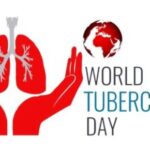Since the discovery of the Bacille Calmette-Guérin (BCG) tuberculosis vaccine in the 1920s, an effective vaccine that can adequately protect adolescents and adults from the disease has not been developed.
The BCG vaccine doesn’t work in adults and is often given to infants and children in countries where the disease has high prevalence to protect them from the more invasive forms.
- Palestinians recount ‘ruthless’ horrors of Israeli raids in Gaza, 122 killed
- Does Nigerian music glorify cybercrime? Here’s why this matters
Tuberculosis is an airborne disease caused by a bacterium called mycobacterium tuberculosis, which mainly affects the lungs and other parts of the body.
Some symptoms of the disease include cough lasting longer than two weeks in normal individuals, and any current cough in people living with HIV and AIDS, weight loss, night sweats and persistent fever.
Tuberculosis is a leading infectious disease in the world, affecting 10 million people each year and claims 4,000 lives daily. It claimed 1.4 million lives in 2019.
The disease remains a major public health problem in Nigeria. The country has the highest tuberculosis burden in Africa and ranks sixth globally, according to the 2020 WHO Global TB report.
It is estimated that tuberculosis kills 18 Nigerians every hour. Over 400,000 estimated cases occurred in 2019, with over 150,000 deaths.
Medical experts said tuberculosis control goals could not be achieved without safe and effective vaccines.
According to Dr Saswata Dutt, a senior technical adviser, HIV/TB/Drug Resistant-TB in the Institute of Human Virology, Nigeria (IHVN), “There is currently no vaccine that is effective in preventing tuberculosis in adults, either before or after exposure to infection, although results from a phase II trial of the M72/AS01E candidate are promising.”
He said the only licensed vaccine for prevention of the disease is the BCG vaccine.
“The BCG vaccine, which was developed almost 100 years ago, prevents severe forms of tuberculosis in children, and is widely used.
“Vaccination of children with the BCG can also confer protection, especially in severe forms,” he said.
He explained that tuberculosis required a multidrug course of treatment lasting six months or longer for drug-resistant form. Treatment failure and recurrence after end of treatment can have devastating consequences and may be associated with the development of drug-resistant variant.

Why is it difficult to get another vaccine till date?
The country director of the KNCV Tuberculosis Foundation Nigeria, Dr Bethrand Odume, said the key challenges to tuberculosis vaccine development was the difficulty in understanding the type of immune responses the body would need to mount to be able to be protected.
“For many diseases that have been prevented using vaccines, protection is usually achieved by the body acquiring immunity from exposure to such a germ, where the body builds a natural immune protective mechanism, or a vaccine making the body to produce more of such defensive mechanisms.
“But it is known that exposure to mycobacterium tuberculosis, the germ that causes the disease, does not induce sufficient protective immunity,” he said .
However, he added that not enough is known about the complex nature of the body’s native protective mechanism and adaptive human immune responses needed for natural clearance of the tuberculosis germ.
This knowledge is needed to facilitate tuberculosis vaccine development, he added.
What is the status of vaccine research now?
Dr Dutt said tuberculosis vaccine candidate pipeline had various vaccine platforms, including whole cell vaccines, adjuvant proteins and recombinant subunit vector vaccines.
He said, “Candidate vaccines are being developed for prevention of tuberculosis in adolescents and adults for early life immunisation as BCG replacement, boosters for vaccination of patients after treatment to prevent disease recurrence, or as immunotherapeutic adjuncts to drug therapy intended to reduce treatment duration (these are the ways that will help reduce tuberculosis burden).”
He said there were 14 vaccines in phases I, II or III trials, adding that there are currently three vaccine candidates.
He further said, “Recently, an investigational vaccine candidate (M72/AS01E) was found to be significantly protective against the disease in a Phase II (b) trial conducted in Kenya, South Africa and Zambia in individuals with evidence of latent infection.
“The point estimate of vaccine efficacy was 50 per cent (90% CI, 12-71), over approximately three years of follow-up. This result, unprecedented in decades of tuberculosis vaccine research in terms of clinical significance and strength of evidence, constitutes an important scientific breakthrough.
“Beyond clinical trials that measure safety and efficacy, additional evidence around the social, economic and population health benefits are needed to inform effective introduction and implementation of new vaccines.”
Current treatment regimen versus missing cases
In March, the commissioner for health in Kano State, Dr Aminu Tsanyawa said 20,522 tuberculosis patients in the state went ‘missing’ after testing positive.
Some people are of the opinion that many patients abandon treatment or run away from it because they are afraid of the long treatment period (with drugs and injections).
Experts, however, said while new vaccines are very important, treatment regimen for tuberculosis is not as long as before.
Dr Dutt of IHVN said, “To start with, injectable treatment has been completely abolished in favour of fully oral treatment or drug-resistance, except in specific cases (when necessary).
“Tuberculosis treatment is shorter than many lifelong treatments like hypertension, diabetes or HIV. But taking into consideration that anti-tuberculosis drugs generally are not user-friendly, there is an implemented system called Directly Observed Therapy Short-course (DOTS).’’
The country director of the KNCV Tuberculosis Foundation Nigeria, Dr Bethrand Odume explained that the treatment is of two types.
“There is treatment for what we call the normal TB; that is the form that has not developed resistance to the first line drugs used in treatment. For this form of tuberculosis, the treatment lasts for six months, using oral drugs. In most cases, when the patient takes drugs under supervision and completes treatment, almost 100 per cent of the cases will be cured.
“The second form of treatment is for what we call the multi-drug resistant TB. This is the form of tuberculosis that is resistant to the two most powerful drugs.
“Treatment could last longer for up to 24 months. The drugs also come with some injections and very serious side effects, worse of which is the effect in hearing.
“Lately, a new form of treatment lasting for six months has been developed and being rolled out in Nigeria by the National TB Programme, with technical support from the KNCV TB Foundation Nigeria and the Hague,” he explained.
Vaccine for adults important – Patients
Babangida Shuaibu, 40, a tuberculosis survivor said a vaccine for adults would help protect more people from the disease. He said his neighbour tested positive but refused to go for treatment and later transmitted it to his daughter.
“We advised him to go to the hospital for treatment after he tested positive, but he refused. He later ran away from the neighbourhood, but his daughter had already been infected by then. The lady is better now, but she really suffered a lot. If she received a vaccine after her father fell ill she would have been spared all the suffering. Some people are not that lucky to tell their stories.
“I would have also been vaccinated and protected from the disease when a relative living in the same house with me began suffering from it. I wouldn’t have needed the 18-month treatment I underwent after contracting the disease,” he said.
A patient who craved anonymity said some people abandoned treatment despite the fact that its regimen had been shortened to six months. She said a vaccine would prevent the spread of the disease, particularly in areas they are prevalent.
Launch of global roadmap for vaccine research, development
Meanwhile, the European and Developing Countries Clinical Trials Partnership (EDCTP) and the Amsterdam Institute for Global Health and Development (AIGHD) have launched a global roadmap for research and development of tuberculosis vaccine.
It was launched during the recent virtual Global Forum on vaccines, organised by the Stop TB Partnership Working Group on New Vaccines, in collaboration with IAVI and the Tuberculosis Vaccine Initiative.
It was launched during a special session that involved researchers, developers, funders, regulators and other key stakeholders.
The roadmap identifies priorities for the development and implementation of new tuberculosis vaccines, with the aim to coordinate and accelerate global action.
The EDCTP said the project was carried out in close collaboration with the World Health Organisation (WHO).
Dr Michael Makanga, the executive director of the EDCTP, said the launch was timely to leverage recent advances and new opportunities arising from lessons learnt from other diseases such as COVID-19.”
“Our enduring commitment to actively contribute to a concerted global research and development effort that will ultimately end tuberculosis is the main drive for investing in this very consultative new global vaccine roadmap,” he said.
Professor Frank Cobelens, chairman of the Executive Board of the AIGHD said, “This roadmap reflects a collective analysis by end-users, implementers, regulators, funders, manufacturers and researchers of the barriers in tuberculosis vaccine research and development and the actions we need to take to overcome them.
“It lists concrete steps we strongly hope would be taken by each of these actors. For COVID-19, collective effort has brought tremendous acceleration of vaccine development. Let’s show we can do this for tuberculosis as well.”
The roadmap was developed through an iterative global consultative process designed to identify the key barriers to tuberculosis vaccine research and development and implementation, as well as potential ways they might be overcome.
Way forward
Also speaking during the virtual Global Forum on TB vaccines, Mark Feinberg, the president and chief executive officer of the International AIDS Vaccine Initiative (IAVI), said the COVID-19 pandemic was an opportunity to push for the development of highly effective vaccines.
Also speaking during the meeting, Lucica Ditiu, the executive director of the Stop TB Partnership said, “COVID-19 showed us that it is possible for the world to come together, develop and deploy a vaccine in one year.”
She called on the TB community to accept nothing less than the same level of support, funding and attention to have a vaccine in 2023.
Dr Dutt of the IHVN said there should be more efforts on the advocacy, communication and social mobilisation part of tuberculosis spectrum to increase awareness in general population, reduce stigmatisation of clients and increase funding from all players (particularly the government sector) to reduce dependency on international donors.
Dr Odume of the KNCV Tuberculosis Foundation Nigeria said that in tuberculosis vaccine, two things are possible: “The vaccine offers complete protection against the disease, and as such, there will be no need for treatment or helping to boost the body’s natural protection, and thus, can reduce duration for those that will need treatment when infected.”




